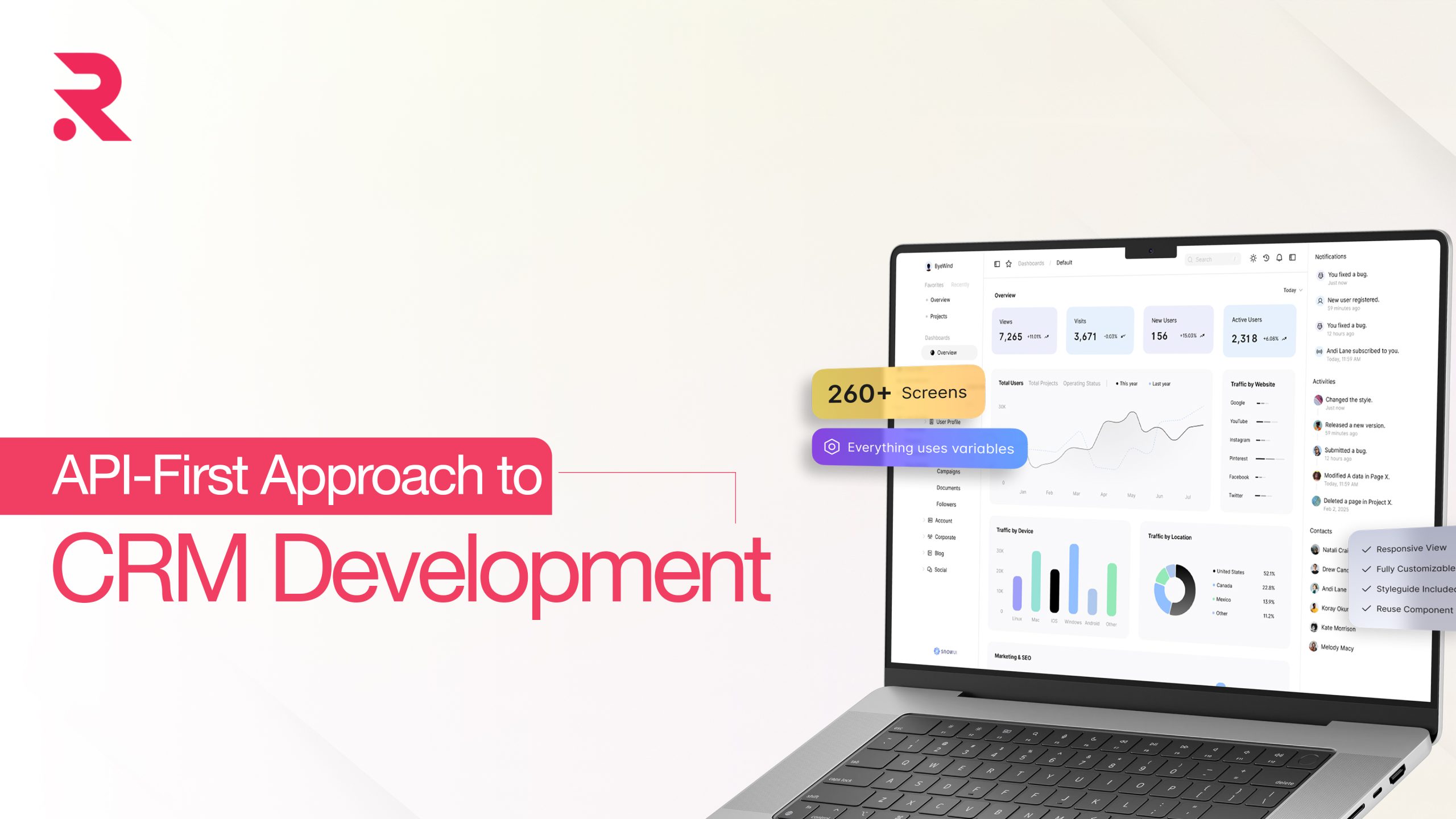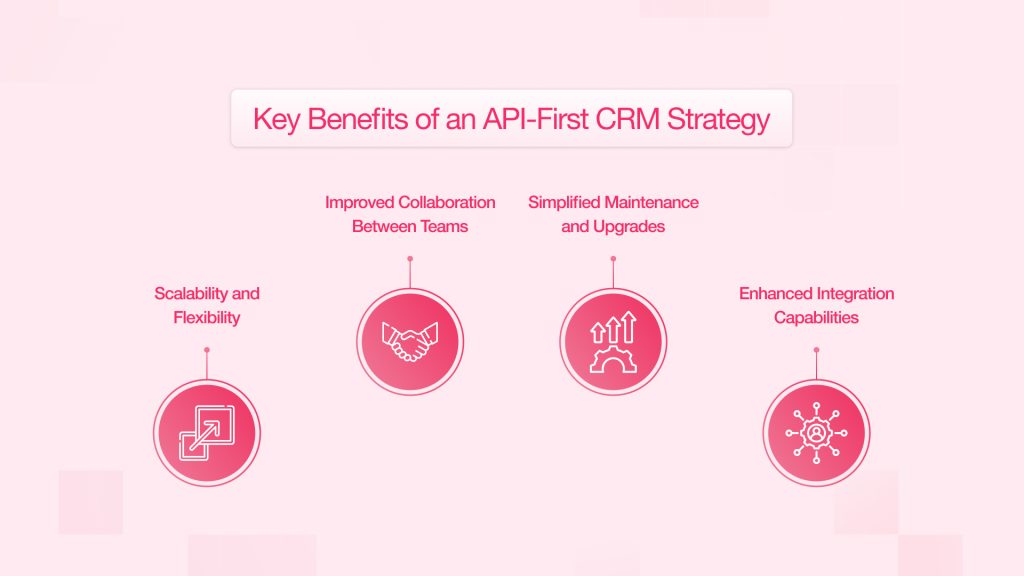API-First Approach to CRM Development: Pros & Use Cases
Adopting an API Approach to CRM Development offers businesses a structured way to build scalable, maintainable, and integrable CRM solutions. This article explores the benefits of this approach and analyses some use-case situations that can complement modern CRM development.
- June 30, 2025
- by Tarun


In the changing nature of customer relationship management (CRM), companies increasingly look for developing systems that are scalable, adaptable, and capable of putting on seamless integration with other platforms. A CRM Development API Approach tries to answer these needs by emphasising the creation of sturdy application programming interfaces (APIs) as the foundation of CRM systems. This method guarantees that CRM platforms will be able to communicate sufficiently with other software applications and exchange data more efficiently to provide the other necessary functions to the system.
In an API-first world, backend and frontend are decoupled in CRM, so there is a lot of flexibility in the development processes that can run parallel to one another. This leads to faster development and less complex maintenance and upgrades. An API-first CRM will be able to integrate better with many third-party applications, whether they be marketing automation tools, analytics software, or whatever, thus widening their usage and application.
This article discusses some of the major benefits of an API Approach in CRM Development and provides insights into how this approach helps to make CRM systems more efficient, scalable, and future-ready. It also looks at several real-world scenarios to show how the approach serves modern-day CRM Development and what benefits it brings.
Understanding the API Approach to CRM Development
Definition and Core Principles
The API Approach to CRM Development is centred on API creation as the primary means for communication between software components. This approach puts an emphasis on API design and development before the actual CRM development so that every functionality can be accessed through a solid interface.
Evolution of CRM Development Methodologies
Traditional CRM systems could often be monolithic, where frontends and backends are tightly coupled, making customisation and integration with other systems difficult. The API-first methodology is a new way towards modular, service-bound architecture so that CRM development can carry more flexibility and occurrence.
Key Benefits of API-First CRM Strategy

Scalability and Flexibility
The API-based decoupling of frontend and backend allows CRM systems to be easily scaled to increase user bases and meet ever-changing business requirements. By having a modular system, components can be independently scaled according to resource availability and performance.
Improved Collaboration Between Teams
Having API contracts defined ahead of time allows both frontend and backend teams to move in parallel so that one group no longer has to hang around waiting for the other to resolve dependencies. A process of this kind would give rise to an even faster rate of overall development and eventually foster additional teamwork and cooperation among development teams.
Simplified Maintenance and Upgrades
An API abstracts interfacing between parts of a system, which lets you upgrade or replace portions of the system freely without causing any impact on others. Such a decoupling also makes it convenient for performing maintenance on a certain component, thereby reducing the risk of generating errors during an update.
Enhanced Integration Capabilities
A good API-first design CRM system integrates easily with hundreds of other third-party app options, including marketing automation tools, analytics platforms, and customer support systems. This ability to interoperate boosts the CRM’s utility and gives a full lifecycle view of the customer.
Looking for a Partner in Your CRM Development Journey?
We Can Help!
Practical Use-Cases of API-First CRM Development
Integration With Third-Party Applications
In any modern environment, the business depends on multiple systems to carry out various facets of operation. Marketing, sales, customer support, inventory, and analytics platforms all have to transfer data efficiently. API Approach to CRM Development ensures some kind of interoperability from the very beginning.
Example:
A B2B SaaS company using HubSpot for marketing and Zendesk for customer support can use a custom CRM built with an API-first approach. Using the well-documented REST APIs, the CRM will pull lead data from HubSpot and begin to update support ticket details from Zendesk. These real-time integrations allow sales and support teams to have consistent and updated information present on these platforms.
Benefits:
- Cuts manual data entry errors and synchronisation.
- Automation in workflow integration across systems.
- Help any reporting dashboards that can consolidate customer info from a number of tools.
Support for Mobile and Web Platforms
Customers and sales professionals today expect to interact with their CRM software regardless of whether the interface is desktop-based or an app on their tablet or smartphone. The API-first approach accommodates this need by allowing multiple client interfaces (mobile apps, web apps, browser extensions) to access the same backend services via common endpoints.
Example:
Imagine a real estate company that builds a mobile CRM app while on the field for agents to fetch property details, customer interactions, and sales pipeline on the go. The mobile and web versions of the app are different front ends, consuming the same APIs to ensure data consistency between platforms.
Benefits:
- Avoids duplication of efforts (write once, consume many times).
- Ensures real-time updates on all devices.
- Makes app maintenance much easier because all business logic resides in the API layer.
Enabling Data-Driven Decision Making
With structured and accessible custom or third-party APIs, companies develop a data layer so that analytics tools can easily query and interpret data to generate insights on customer behaviour and campaign execution, thus going deeper into sales trends.
Example:
A retail brand uses the CRM’s API to pass customer interaction data into a BI platform such as Tableau or Power BI. There, the marketing and sales leadership can create real-time dashboards for viewing information about lead conversion rates, customer lifecycle stages, or engagement across campaigns.
Benefits:
- Allowing more accurate forecasting.
- Allowing the identification of customer segments and engagement opportunities.
- It allows for compliance reporting against standardised data retrieval.
CRM-as-a-Platform for External Developers
Some of the organisations make their CRM APIs available to partners, vendors, or customers to foster new business models and integrations. This turns the CRM system into a platform for development rather than just into a data repository.
Example:
A telecom vendor exposes certain parts of its CRM to third-party resellers, who can view customer data, inventory, and trigger service activations using secure APIs. These external teams then build their own portals and applications with the CRM serving as the central system of record.
Benefits:
- Promotes ecosystem development and third-party value creation.
- Decreases internal burden by passing on work to partner systems.
- Retains control over data access through defined API scopes and limits.
Need a Reliable CRM Development partner to help grow your Business?
Our Experts Can Help!
Best Practices for Implementing an API Approach to CRM Development

Defining Clear API Specifications
Creating a well-defined API specification beforehand establishes the parameters of an interface design that is consistent and reliable. The lack of detailed and transparent specifications leads to conflict and integration issues. Clear and consistent API specifications are paramount. Standardisation with OpenAPI (the former Swagger) permits a team to design and document APIs in a methodical way. Such detailed specification ensures correct implementation, automated testing, client SDK generation, and consistent developer onboarding.
Ensuring Robust Authentication and Authorisation
Given that APIs expose critical data and functions, strict access control needs to be enforced. OAuth 2.0 or JWT (JSON Web Tokens) can be imposed for identifying who is accessing the APIs and what actions they perform. Security must be addressed at every stage — from transport encryption (HTTPS) to data access policies.
Want to keep your website secure from cyber-attack? Here are a few tips for you.
Implementing Comprehensive Monitoring and Analytics
API usage should be monitored to ensure system reliability and the detection of performance issues. API gateways, logging frameworks, and APM solutions such as New Relic or Datadog provide real-time insights into usage patterns, error rates, and latency; such insight then guides upon improvements or usage enforcement.
Establishing Effective Version Control Mechanisms
APIs need to maintain backward compatibility when they evolve. Semantic versioning allows the consumers to acknowledge changes and update their integrations accordingly. Avoiding breaking changes should always be the goal; if there is one, provide a good deprecation policy with adequate transition time. Ensuring that these changes are well documented will greatly mitigate any confusion.
Designing for Consumer Experience
APIs should be intuitive enough for external developers as well as internal teams to use. Following RESTful design principles, or GraphQL when appropriate, makes sure that endpoints are visible, predictable, stateless, and easy to navigate while creating a powerful customer experience platform. API design must be consistent, well-named, and behaviourally transparent. Documentation, preferably automatically produced and interactive, should contain examples and use case scenarios.
Future Trends in CRM Development
Several trends of development of the CRM approach are in evolution besides known API-first approach benefits:
Headless CRM Systems
Just as headless CMS platforms emerged, the concept of headless CRM is also gaining momentum. These systems provide no fixed frontend, whereby the business can craft totally custom interfaces using APIs, and meanwhile, the backend takes care of data storage, rules, and logic.
GraphQL for Flexible Queries
Some CRM platforms have adopted GraphQL for more flexible and efficient queries concerning data. In contrast to REST, for which multiple endpoints exist for each resource, GraphQL allows clients to make a single request and specify the exact data they want to receive, thus either respecting issues of over-fetching or under-fetching.
Event-Driven APIs and Webhooks
Event-driven architectures are gradually being used by CRM systems instead of polling for data changes; they notify clients in real-time through webhooks, thus increasing the responsiveness of integrated systems.
More Attention to API Governance
As more teams develop and rely on APIs, companies are increasingly formalising their frameworks around API governance. This, therefore, includes laying down rules for the naming conventions, versioning policies, security standards, and lifecycle management.
Integration of AI and Automation
Exposed via APIs are many AI solutions such as predictive lead scoring, customer sentiment analysis, and chatbot implementations. This way, AI intelligence can be integrated into CRM via machine learning services without burying it inside the application codebase.
Conclusion
Choosing an API Approach to CRM Development does not entail merely a technical decision; rather, it is strategic in that it influences how organisations build, integrate, and evolve customer systems. This implies support for the increasing need for modularity, scalability, and cross-platform accessibility in the frameworks of present-day software architecture.
Customer interactions grow many folds in complexity, and thus the CRM systems need to meet new and other touchpoints. API-first development fosters these traits through the fact that APIs become the core through design and application.
An investment in an API-oriented CRM infrastructure thus provides a growing organisation with ample capacity for innovation and agility, specifying how businesses handle customer relationships.
 Shopify
Shopify

















